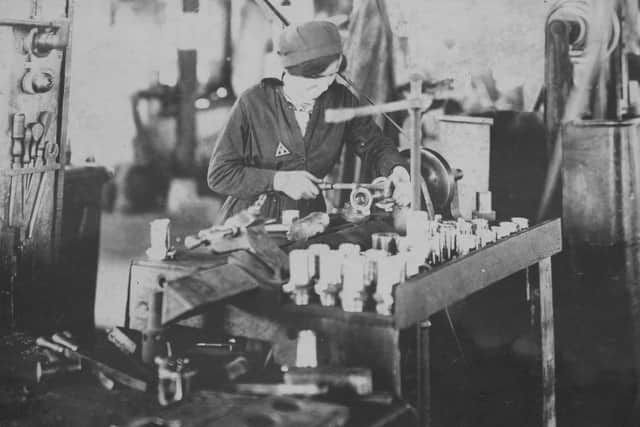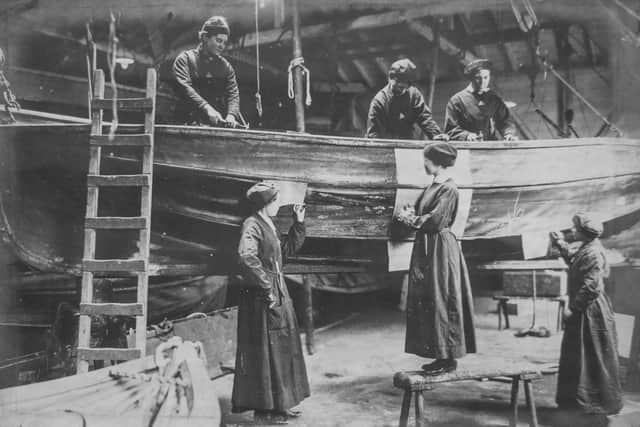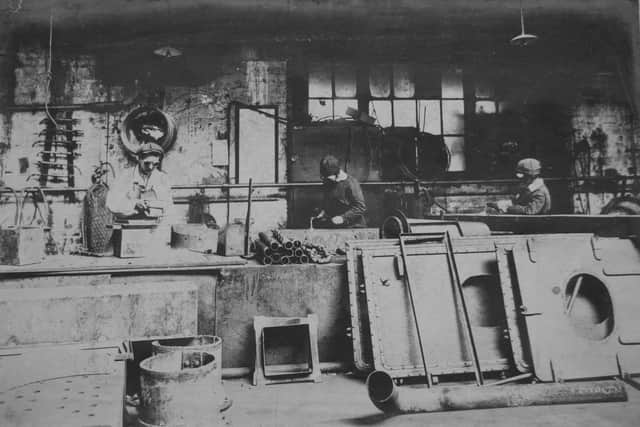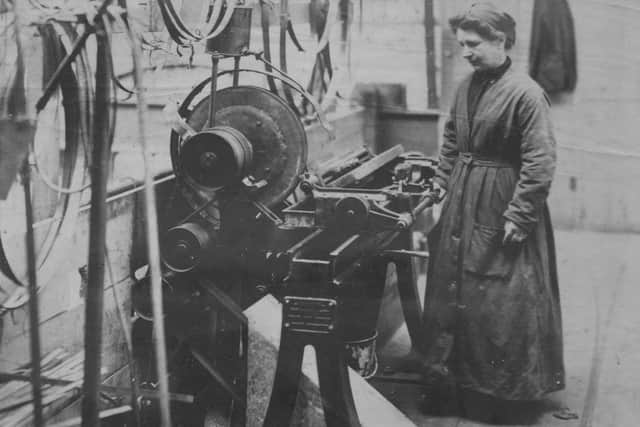Discover the women who kept Portsmouth Dockyard going in the First World War


At Portsmouth Dockyard, 1,750 women were drafted in to undertake industrial work, alongside about 2,000 members of the WRNS – in tasks hitherto filled by men.
The Portsmouth Royal Dockyard Historical Trust has been awarded a Heritage Lottery Fund grant to research this work and it will include an impressive photographic album of 50 images, some of which are printed here.
Advertisement
Hide AdAdvertisement
Hide AdThe unique archive shows women hard at work at heavy industrial dockyard jobs. The huge machines often dwarfed the women operating them.


The women were known as Triangle Girls because of the On War Service badge they wore. In the fascinating pictures the workers concentrate on their jobs without looking at the photographer.
It’s possible their dockyard boss ordered this special record of the women doing men’s work for the first time.
Experts at the Imperial War Museum know of no other photographic album focused on women’s work on a single industrial site.
Advertisement
Hide AdAdvertisement
Hide AdThe 50 plates show lighter tasks such as repairing and painting small boats and liferafts, making mattresses, mixing paint, painting lifebelts and sewing canvas.


But there are far more illustrations of much heavier work.
The list at the front of the album describes what women are doing in each picture and the locations – including the Boat House, Test House, Joiners’ Shop and Block Mills.
In 1982 when the dockyard was downgraded to a fleet maintenance and repair base, I was asked to be secretary to the group of skilled craftsmen who founded the Portsmouth Royal Dockyard Historical Society to save the special documents, tools and equipment of the civilian workforce used by generations of local people who built, repaired and equipped the navy’s ships.
The Science Museum told us that the shipwrights’ tool collection was the finest in the country.
Advertisement
Hide AdAdvertisement
Hide Ad

Later the society became a trust, and its millions of fascinating items are now safely stored in Storehouse 10 and other locations in the dockyard.
As the change of the yard’s status and the cuts to the workforce were such a profound loss to the members of the Society and to the dockyard’s long traditions, I decided to record a wide range of the specialised skilled trades in the yard.
These recordings are available to listen to in the Portsmouth History Library.
In 1986 I wanted to find women who might still be alive who had worked in the yard in the Great War.
Advertisement
Hide AdAdvertisement
Hide Ad

To my astonishment, four responded to my letter to The News.
What they told me brought alive the pictures, but also how much they had suffered to get these jobs.
War widows and those with relatives in the yard had the first choice of dockyard jobs. There was no social security then.
By the time I recorded them they were in their late 80s and 90s. They had extraordinary stories to tell.
Advertisement
Hide AdAdvertisement
Hide AdBeatrice Hobby, born in 1891, married very young but lost her first husband Bill Penfold who was gassed in the trenches. She was left a widow with a six-week-old baby, so she had to work to support him.
With experience of cardboard box assembly at Leetham’s Corset Factory from the age of 13 when she left school, she was used to manual work. She was employed in block making, hose-making and cleaning Carley floats.
![Beatrice Hobby wears her uniform with pride. Picture: Portsmouth Royal Dockyard Historical Trust]](https://www.portsmouth.co.uk/webimg/legacy_oak_1.8880000.jpg?crop=3:2,smart&width=640&quality=65)
![Beatrice Hobby wears her uniform with pride. Picture: Portsmouth Royal Dockyard Historical Trust]](/img/placeholder.png)
She had to go home in her lunch break on the tram or bus to bring her right round the dockyard wall to her mother’s house in Duke Street to feed her baby, have her dinner and then get all the way back via the Hard to Block Mills. In her words, ‘Quite a rush!’
Beatrice was 93 when I interviewed her. I took a pulley block with me, and the memory of how she shaped it came back to her as she turned it over in her hands. She worked on the bandsaw.
Advertisement
Hide AdAdvertisement
Hide AdThere were accidents. A machine took the top of a girl’s finger off.
The women worked without masks, despite the dust, or ear defenders, despite the noise.
Maudie Ralph’s grandfather, father and brothers worked in the yard. She was born Maud Emily Bower on 20 March 1890. Her husband, who was in the Grenadier Guards, was posted missing, though his death was not confirmed for seven long months.
She had two little girls to support, and she ‘had to do something’, so she asked to go into the dockyard. She had made corsets when she was a single girl.
Advertisement
Hide AdAdvertisement
Hide AdShe had six brothers, and enjoyed her time on ships, drilling hammock hooks for sailors on HMS Edinburgh Castle and the Resolution.
Valentine Stubbs was born in 1893. Her father went down on board HMS Victoria in 1893. She left school at 14 and worked in a corset factory until she was nearly 15, then worked in the dockyard from November 1916 to March 1919.
She did various jobs including working on a boring machine powered by steam power, winding the wires round hoses, and welding as an oxyacetylene operator, a dirty but interesting job which was new technology then.
Changing the carbide supply was a stinking task. She describes the flame coming out of the gun, with which she had to weld all the way down the seam and join it together.
Advertisement
Hide AdAdvertisement
Hide AdFor more fascinating tales of dockyard life, go to Portsmouth Royal Dockyard Historical Trust at portsmouthdockyard.org.uk.
Resentment faced by women
The women workers had to, at first, take considerable abuse from men.
They faced daily taunts and hustling and pushing on their way into work. One woman said that it was as well to carry an umbrella with you on the trams ‘to give as good as you got.’
It is believed to have been down to resentment at the ‘dilution’ of dockyard work.
Advertisement
Hide AdAdvertisement
Hide AdMary Macarthur, general secretary of the Women’s Trade Union League, is quoted as saying at the time: ‘Of all the changes wrought by the War, none has been greater than the change in status of women, yet it is not so much that woman herself has changed as that men’s conception of her has changed.’
But widow Maudie Ralph had a happier experience.
She said: ‘They used to laugh at me because I was only little.
‘I was only short but I was all there, I ought to tell you.
‘They used to make me laugh. A young apprentice chap used to teach me the songs’
How will the records be used?
Celia Clark’s research on the album and other photographic records of women’s First World War work in naval bases is to be published in the Naval Dockyards Society’s Transactions in June.
Advertisement
Hide AdAdvertisement
Hide AdThe Portsmouth Royal Dockyard Historical Trust has a grant from the Heritage Lottery Fund to research the Portsmouth’s women’s work and their lives further.
They will use the trust’s extensive employment records and Celia’s research to develop educational materials for schools, in celebration of the key role played by generations of civilians employed in the dockyard who built, repaired and supplied the ships of the Royal Navy.
The Trust kindly gave permission to reproduce the photographs in this article, which were copied by Martin Marks OBE.